Reducing pilates
This exercise uses a program of holistic stretching that helps to prevent and reduce weight gain through controlling your breathing and strength, and concentrating on your center of energy.
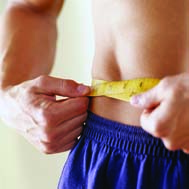
+ Pilates is a conditioning form of controlled movements that improves your strength and flexibility without building big muscles. Pilates can help you lose weight by toning your body and conditioning your muscles, especially in the center zone where some tend to build up fatty tissue. It uses the non-impact exercises devised by Joseph Pilates to develop strength, flexibility, balance and physical awareness.
THE FOUNDER
Founded by Joseph H. Pilates, around seventy years ago, it has recently gained new interest among chiropractics, physical therapists and anybody recovering from soft tissue injuries. Born in Germany in 1880, Joseph H. Pilates had a lifelong interest in body conditioning. As a frail child dedicated to becoming stronger, he later grew to become an accomplished skier, diver, gymnast, and boxer. At the outbreak of World War I, Pilates was interned as an “enemy alien” with other German nationals in England. During his internment, he refined his ideas and trained other internees in his system of exercise. He rigged springs to hospital beds, enabling bedridden patients to exercise against resistance, an innovation that led to his later equipment designs. An influenza epidemic struck England in 1918, killing thousands of people, but not a single one of Pilates’ trainees died. This, he claimed, testified to the effectiveness of his system. He opened a fitness studio in New York and continued to train clients at his studio until his death in 1967 at the age of 87. Today, five million Americans practice Pilates, and the numbers continue to grow all over the world.
One hundred
Lying on your back, with your spine straight and your arms relaxed to the sides of your body. First bend your knees slightly and bring them up to hip level. Stretch out your legs and place the soles of your feet on the floor.
Inhale and as you exhale lift up your legs, together, a few inches from the ground. Bring your chin to your chest, without touching and keeping your head in this position. Lift up your arms a few centimeters. Next, move them, coordinating with your breathing. Inhale through the nose and exhale through the mouth five times. While moving your arms the same amount of times. Continue until you reach the number that's the name of the exercise: 100!
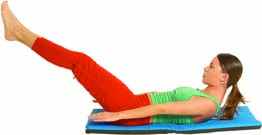
Roll forward
Lying down on your back with your arms stretched out behind your head and your legs straight and together. Inhale and as you exhale, lift your arms up. Inhale and, as you exhale lift up your neck and shoulders and bend over your belly button, continuing to move forward. Continue to move forward over your legs until your hands are at your feet, leave your arms parallel with your legs; see if you can wrap your hands around your toes. In this position, relax. Try to make the back longer with each outbreath. Next, come back to a sitting position, feeling how your spine is stretching. Exhale and lower your back (curved) until you are in the first position. Repeat four times.

Rolling your leg
Lie down on your back with your spine on the mat, but not pressed against it. Inhale; as you exhale lift up your leg trying to align it with your knee and hip. Lastly, trace a semi - circle with this leg, from left to right above your body. Repeat six times with each leg.
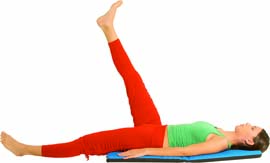
Rocking chair
In a seated position, seated straight on a mat. Keep the abdomen relaxed. Bend your knees and take hold of your ankles, bringing them close to your buttocks. Bring your forehead to your knees. Inhale; as you exhale, cave in your abdomen and rock backward. Leave your head between your knees, without forcing your body. You should concentrate on your abdomen when doing this movement. Continue rocking forward. Repeat six times.
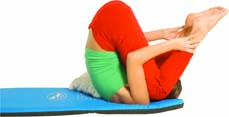
Stretching your leg
Lying down on your back, with your ankles together and your toes pointed outward. Inhale; as you exhale lift up your neck and shoulders. Bend your right knee into your chest and wrap your arms around them. Lift up your left leg a few centimeters, keeping it completely straight. Repeat five times on each leg.

COORDINATION
To strengthen your muscles, you need to “surprise” them, with different movements. So they don't get accustomed and lose agility. Your breathing should coordinate with your movements.
Stretching both legs
Lying down on your back with your spine relaxed, (not pressed against the mat, nor lifted up from it). Your arms and legs should be stretched out, ankles together and toes pointed forward. Inhale; as you exhale lift up (all at the same time) your neck, shoulders, arms and legs stretched out, trying to stretch them out even further. Inhale, as you exhale bend your knees, wrap your hands around your ankles and keep your legs to your chest, keeping your head in the same position. Repeat six times.

Forward backstretch
In a seated position with your back straight and your legs to the sides of your body. The palms of your hands should be on the mat. Your legs separated hip width and your toes pointed toward the ceiling. Lift your arms forward and place your hands on your knees. Inhale; as you exhale start to lower your back, keep it curved forward, bringing your forehead toward your knees. Curve your belly and continue to lower as much as you can, until your arms are parallel with your legs. Exhale and return to the initial position. Repeat six times.
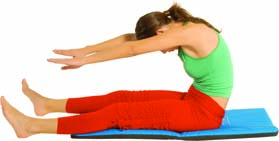
THE BENEFITS OF PILATES
Pilates is an exercise routine that unifies the body and mind. The smooth, steady movements quiet your mind and soothe your nervous system. The body is strengthened and toned, posture is improved. Stress and exhaustion diminishes and sleep improves. With regular practice the mind gains a better clarity and sense of well-being. Each session involves movements that work the entire body, using deep muscles and oxygenating and detoxifying the body.

Comment about this article, ask questions, or add new information about this topic: